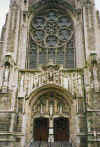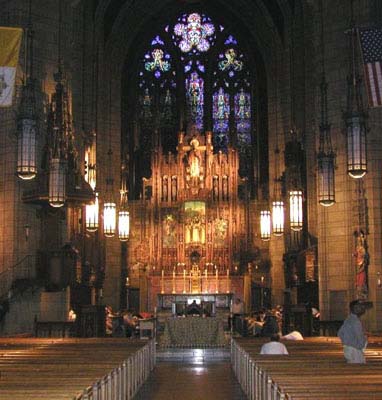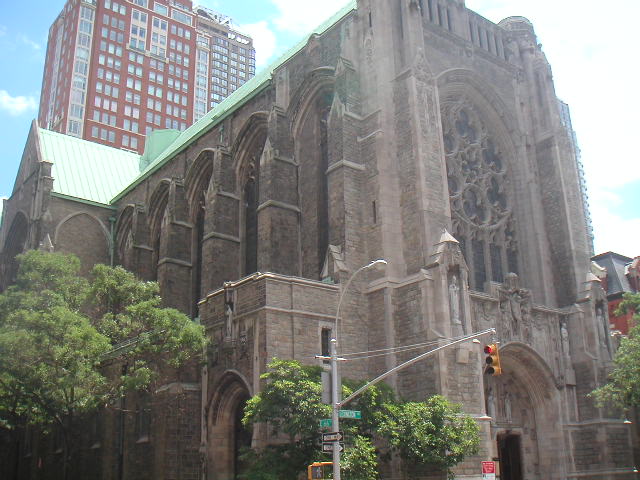 |
New York
Architecture Images-Upper East Side Church Of St. Vincent Ferrer (RC) |
|||||
|
architect |
church, Bertram Goodhue, 1914-18; priory, William Schickel, 1880-81; Holy Name Society Building, Wilfred E. Anthony, 1930; school, Elliot L. Chisling-Ferrenz & Taylor, 1948 | |||||
|
location |
869 Lexington Avenue and 141-151 East 65th Street | |||||
|
date |
1914-18 | |||||
|
style |
Gothic | |||||
|
construction |
stone | |||||
|
type |
Church | |||||
|
|
 |
|||||
 |
||||||
|
notes |
Introduction In the midst of Manhattan's Upper East Side lies the striking French Gothic church of St. Vincent Ferrer. Located on Lexington Avenue between 65th and 66th Streets, the church is one of New York's greatest architectural adornments. The Church was built by the Dominicans - also known as he Order of Preachers. The Dominicans originated in the Catholic Church in the Middle Ages. The order was founded in 1215 by St. Dominic. History In the 1860's a Dominican priest from France, Father Thomas Martin, was sent to the diocese of New York and took up residence in a brownstone on Lexington Avenue and 62nd Street. Father Martin along with some other Dominican fathers began to construct a chapel on the northeast corner of 65th Street. The first mass was offered in this chapel on July 2, 1867. This structure had never been intended to be a permanent place of worship, but it would soon become so. By 1869 the construction was expanded and on December 12 a second church was dedicated. This church would serve the congregation until 1914, when it was demolished. Soon after the destruction of the second church construction began on a new one. On October 22, 1916 the construction of the present incarnation of St. Vincent was completed. It was dedicated on May 5, 1918. The completion of the final structure was designed by some of the greatest architects of this century. Architecture St. Vincent Ferrer was designed by Bertrand Grosvenor Goodhue. In a recently published book on American architecture, St. Vincent Ferrer is named as one of the fifty most beautiful structures in the country, and it was also named Goodhue's greatest work on an ecclesiastical structure. Goodhue designed the church at a time when Gothic Revival was at its highest point. He designed the church in the style of Fourteenth Century French Gothic with echoes of Norman Romanesque. Exterior
The front entrance of the church is a striking masterpiece of stone and glass which focuses on the life of Christ. The emblems of the twelve apostles surround the outer circle of the window and below this window is a stone carving of the Crucifixion. This was carved by Lee O. Lawrie, America's greatest sculptor at that time. Surrounding this magnificent sculpture are the emblems of the passion. By placing the crucifixion outside the church Goodhue created an extremely new and unique design. Up until that time, the crucifixion had never been placed outside of the church, and even today it is a rarity. Framing the crucifixion is a crucifixion group represented by Saints Francis of Assisi, Vincent Ferrer, and Dominic. Also within the design are over thirty other Saints, Popes, and Doctors of the Church. The exterior of the church is constructed of random ashlar and trimmed with dressed limestone, and the church's roof is covered in copper. The church was originally planned to have a fifteen story steeple. However, construction became too difficult to build. An ancient canal that passed under the site, as well as the construction of subway tunnels down Lexington Avenue made it impossible to lay the foundation. Interior
The main body of the church is one of the most beautiful and stunning sights one could ever see. The first thing that grabs one's attention is the High Altar. This is the focal point of the church. The center piece of the altar is the tabernacle which is covered in gold and precious metals. There are five marble steps that lead to the altar. The altar is shaped like a sepulchre, the purpose of which is to remind people that the early Christians had to celebrate mass in catacombs. The stained glass windows within the church are magnificent works of art. The majority of these windows were contrived by the master craftsman Charles Connick, under the direction of Goodhue. The windows were designed to complement each other. The windows with dominant blues interact with the windows with dominant reds, and with the help of the sun they create a exquisite mix of light in the front of the church. Another aspect which makes the interior of the church extremely unique is the Stations of the Cross. The Stations, are not plaques, like most churches, they are large oil paintings. These paintings were done by Telford Paullin and his wife. Paintings, rather than plaques were used because paintings are used in other Dominican churches in Spain. Throughout the interior of the Church there are several statues of Saints and holy figures. The shrine of Our lady of Fatima, contains one such statue. The statue of Our Lady of Fatima was actually sculpted by a priest, Fr. Thomas McGlynn. Fr. McGlynn worked personally with one of the children who had the vision of Mary at Fatima to help him design the life-size statue. The statue of St. Vincent Ferrer is visible from almost anywhere in the church. The statue is made of marble and is life-size. St. Vincent Ferrer is shown wearing a Cappa, the black preaching cloak of the Dominican Order, his hand is raised and the flame of the holy spirit is above him. There is a bell next to the statue which is rung by petitioners when praying to St. Vincent. Interesting Facts about St. Vincent Ferrer
Bibliography Kirkham, Richard, St Vincent Ferrer A Church For All Seasons Pages 1-17. |
|||||
|
links |
Dominican Order Page |